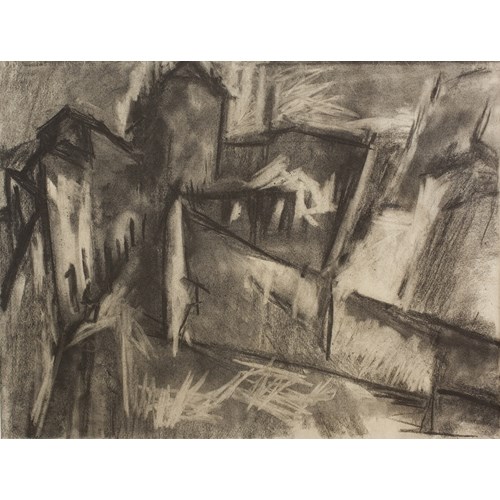Marketplace
Ronda with Iglesia Espiritu Santo
David BOMBERG
Ronda with Iglesia Espiritu Santo
Date 1954
Dimension 45 x 60 cm (17³/₄ x 23⁵/₈ inches)
The fifth child of a Polish immigrant leather worker, Bomberg spent his earliest years in Birmingham and then grew up in the Whitechapel area of London. He suffered considerable financial hardship while studying at evening classes given by Walter Byes (1869-1956) at the City and Guilds Institute from about 1905 to 1908 and by Walter Sickert at Westminster Art School from 1908 to 1910. With the help of John Singer Sargent and the Jewish Education Aid Society, he secured a place at the Slade School of Fine Art, London, in 1911. It was a period of dramatic change, stimulated in part by Roger Fry’s two Post-Impressionist exhibitions and the display of Italian Futurist works at the Sackville Gallery in 1912. Bomberg was one of the most audacious painters of his generation, proving in works such as Vision of Ezekiel (1912) and Ju-jitsu (c.1913; both London, Tate) that he could absorb the most experimental European ideas and come up with a robust style of his own. Later he would evolve a form of expressionism that reflected a personal response to the landscape around him and in his famous classes at the Borough Polytechnic in the 1940s and 1950s urged artists to seek the “spirit in the mass”.
Bomberg travelled to Spain for the first time in 1929. There he broke through to a more free and expressive style and every work arose from intense observation of the motif. The city of Ronda in Andalucia, where Bomberg moved in 1935, is perched on a rocky plateau before a spectacular gorge, a dramatic position to which the artist responded with great intensity. In 1954 Bomberg returned to Ronda. He had not been back to Spain since 1935, when he had been forced to flee the Spanish Civil War. His being there again rekindled the intensity with which he had reacted to the landscape two decades before. Ronda would be once again for Bomberg the subject of several powerful paintings and drawings made on the spot, in the last years before his death.
His charcoal studies from the period are dominated by powerful black contours that give structure to looser and more unruly areas. Forceful zigzags animate the composition and the artist seems to have used his fingers as well as his charcoal stick, achieving dramatic contrasts and richness of texture. Concentrating on the buildings with a certain form of urgency, as shown by the rubbed charcoal or the sharp angles that seem to be close to collapsing, Bomberg eloquently expressed his reaction to his surroundings.
Bomberg travelled to Spain for the first time in 1929. There he broke through to a more free and expressive style and every work arose from intense observation of the motif. The city of Ronda in Andalucia, where Bomberg moved in 1935, is perched on a rocky plateau before a spectacular gorge, a dramatic position to which the artist responded with great intensity. In 1954 Bomberg returned to Ronda. He had not been back to Spain since 1935, when he had been forced to flee the Spanish Civil War. His being there again rekindled the intensity with which he had reacted to the landscape two decades before. Ronda would be once again for Bomberg the subject of several powerful paintings and drawings made on the spot, in the last years before his death.
His charcoal studies from the period are dominated by powerful black contours that give structure to looser and more unruly areas. Forceful zigzags animate the composition and the artist seems to have used his fingers as well as his charcoal stick, achieving dramatic contrasts and richness of texture. Concentrating on the buildings with a certain form of urgency, as shown by the rubbed charcoal or the sharp angles that seem to be close to collapsing, Bomberg eloquently expressed his reaction to his surroundings.
Date: 1954
Dimension: 45 x 60 cm (17³/₄ x 23⁵/₈ inches)
Provenance: Private collection, UK
Literature: R. Cork, David Bomberg London, 1987
David Bomberg, Tate Gallery, London, February – May 1988, exhibition catalogue by R. Cork
David Bomberg, Spirit in the Mass, Abbot Hall, Kendal, July - October 2006, exhibition catalogue with an introduction by R. Cork
David Bomberg en Ronda, Museo Joaquin Peinado, Ronda, October 2004, exhibition catalogue with forewords by R. Cork and M. Jacobs
More artworks from the Gallery









_T638676151429242934.jpg?width=500&height=500&mode=pad&scale=both&qlt=90&format=jpg)